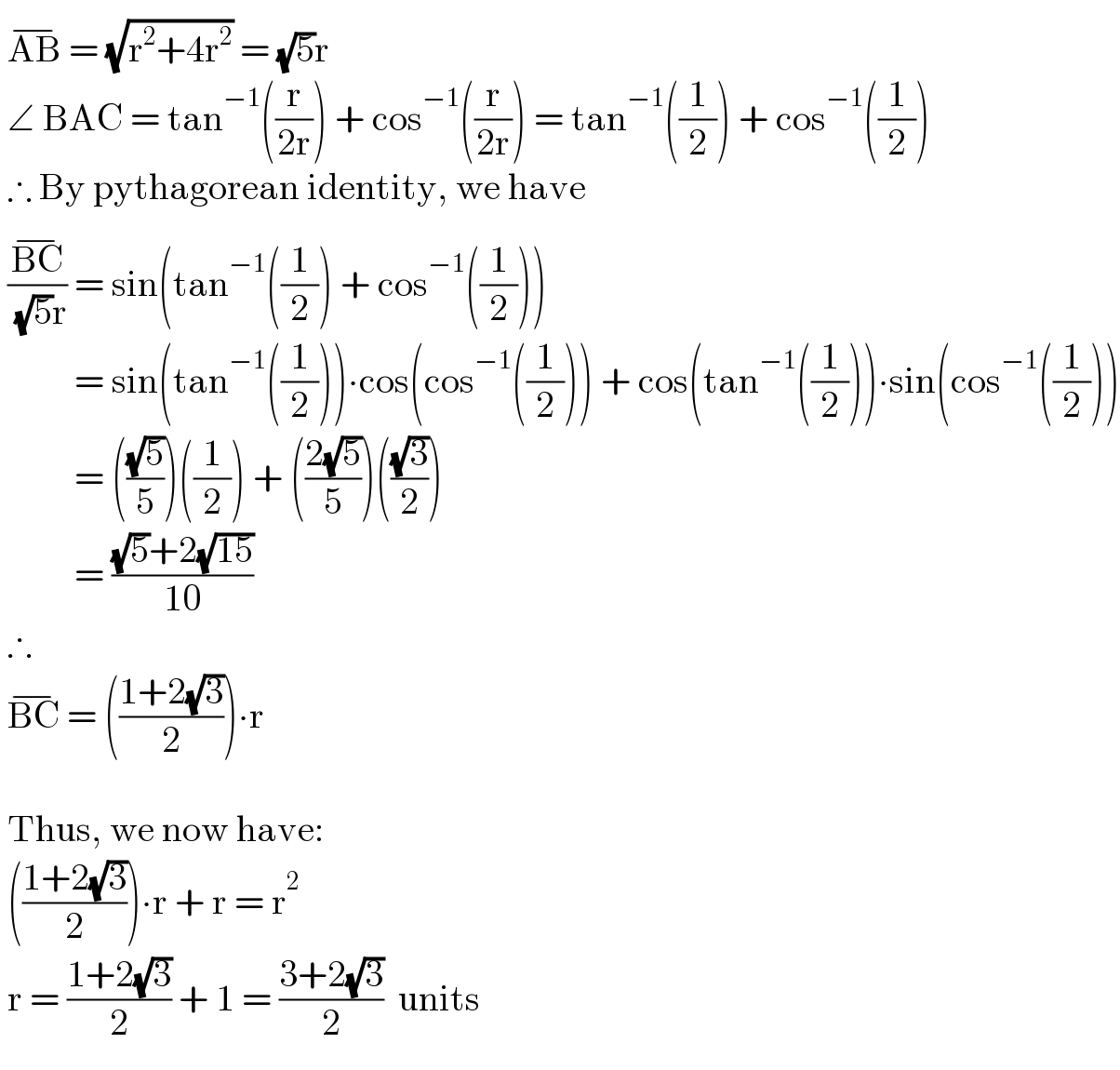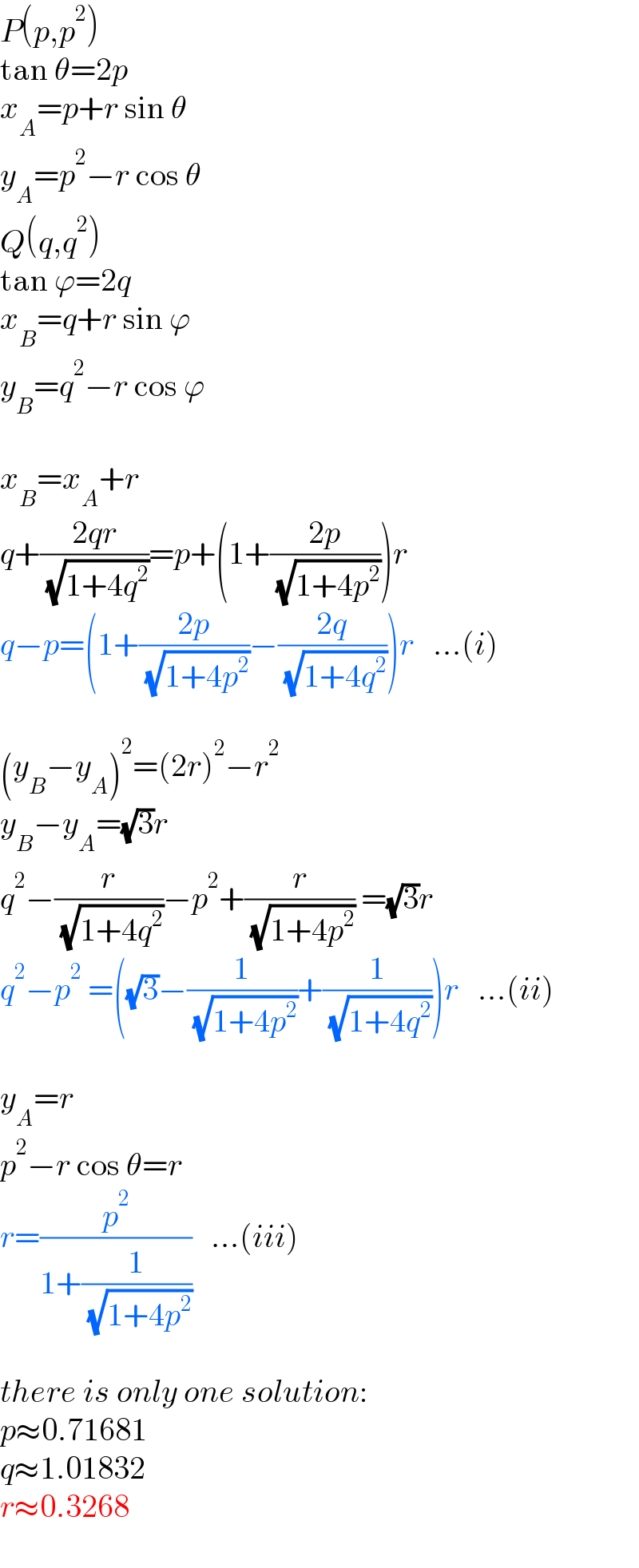Question Number 166208 by ajfour last updated on 15/Feb/22

Commented by ajfour last updated on 15/Feb/22

$${If}\:{both}\:{circles}\:{have}\:{equal}\:{radii}, \\ $$$${find}\:{it}. \\ $$
Answered by Eulerian last updated on 15/Feb/22

$$\:\overline {\mathrm{AB}}\:=\:\sqrt{\mathrm{r}^{\mathrm{2}} +\mathrm{4r}^{\mathrm{2}} }\:=\:\sqrt{\mathrm{5}}\mathrm{r} \\ $$$$\:\angle\:\mathrm{BAC}\:=\:\mathrm{tan}^{−\mathrm{1}} \left(\frac{\mathrm{r}}{\mathrm{2r}}\right)\:+\:\mathrm{cos}^{−\mathrm{1}} \left(\frac{\mathrm{r}}{\mathrm{2r}}\right)\:=\:\mathrm{tan}^{−\mathrm{1}} \left(\frac{\mathrm{1}}{\mathrm{2}}\right)\:+\:\mathrm{cos}^{−\mathrm{1}} \left(\frac{\mathrm{1}}{\mathrm{2}}\right) \\ $$$$\:\therefore\:\mathrm{By}\:\mathrm{pythagorean}\:\mathrm{identity},\:\mathrm{we}\:\mathrm{have} \\ $$$$\:\frac{\overline {\mathrm{BC}}}{\:\sqrt{\mathrm{5}}\mathrm{r}}\:=\:\mathrm{sin}\left(\mathrm{tan}^{−\mathrm{1}} \left(\frac{\mathrm{1}}{\mathrm{2}}\right)\:+\:\mathrm{cos}^{−\mathrm{1}} \left(\frac{\mathrm{1}}{\mathrm{2}}\right)\right)\: \\ $$$$\:\:\:\:\:\:\:\:\:\:=\:\mathrm{sin}\left(\mathrm{tan}^{−\mathrm{1}} \left(\frac{\mathrm{1}}{\mathrm{2}}\right)\right)\centerdot\mathrm{cos}\left(\mathrm{cos}^{−\mathrm{1}} \left(\frac{\mathrm{1}}{\mathrm{2}}\right)\right)\:+\:\mathrm{cos}\left(\mathrm{tan}^{−\mathrm{1}} \left(\frac{\mathrm{1}}{\mathrm{2}}\right)\right)\centerdot\mathrm{sin}\left(\mathrm{cos}^{−\mathrm{1}} \left(\frac{\mathrm{1}}{\mathrm{2}}\right)\right) \\ $$$$\:\:\:\:\:\:\:\:\:\:=\:\left(\frac{\sqrt{\mathrm{5}}}{\mathrm{5}}\right)\left(\frac{\mathrm{1}}{\mathrm{2}}\right)\:+\:\left(\frac{\mathrm{2}\sqrt{\mathrm{5}}}{\mathrm{5}}\right)\left(\frac{\sqrt{\mathrm{3}}}{\mathrm{2}}\right) \\ $$$$\:\:\:\:\:\:\:\:\:\:=\:\frac{\sqrt{\mathrm{5}}+\mathrm{2}\sqrt{\mathrm{15}}}{\mathrm{10}} \\ $$$$\:\therefore \\ $$$$\:\overline {\mathrm{BC}}\:=\:\left(\frac{\mathrm{1}+\mathrm{2}\sqrt{\mathrm{3}}}{\mathrm{2}}\right)\centerdot\mathrm{r} \\ $$$$\: \\ $$$$\:\mathrm{Thus},\:\mathrm{we}\:\mathrm{now}\:\mathrm{have}: \\ $$$$\:\left(\frac{\mathrm{1}+\mathrm{2}\sqrt{\mathrm{3}}}{\mathrm{2}}\right)\centerdot\mathrm{r}\:+\:\mathrm{r}\:=\:\mathrm{r}^{\mathrm{2}} \\ $$$$\:\mathrm{r}\:=\:\frac{\mathrm{1}+\mathrm{2}\sqrt{\mathrm{3}}}{\mathrm{2}}\:+\:\mathrm{1}\:=\:\frac{\mathrm{3}+\mathrm{2}\sqrt{\mathrm{3}}}{\mathrm{2}}\:\:\mathrm{units} \\ $$
Commented by ajfour last updated on 15/Feb/22

$${BC}\:\:\neq\:\left(\sqrt{\mathrm{5}}{r}\right)\mathrm{sin}\left(\:\angle{BAC}\right) \\ $$$${please}\:{check}!\:{sir}. \\ $$
Answered by mr W last updated on 15/Feb/22

Commented by Tawa11 last updated on 16/Feb/22

$$\mathrm{Great}\:\mathrm{sir}. \\ $$
Commented by mr W last updated on 16/Feb/22

$${P}\left({p},{p}^{\mathrm{2}} \right) \\ $$$$\mathrm{tan}\:\theta=\mathrm{2}{p} \\ $$$${x}_{{A}} ={p}+{r}\:\mathrm{sin}\:\theta \\ $$$${y}_{{A}} ={p}^{\mathrm{2}} −{r}\:\mathrm{cos}\:\theta \\ $$$${Q}\left({q},{q}^{\mathrm{2}} \right) \\ $$$$\mathrm{tan}\:\varphi=\mathrm{2}{q} \\ $$$${x}_{{B}} ={q}+{r}\:\mathrm{sin}\:\varphi \\ $$$${y}_{{B}} ={q}^{\mathrm{2}} −{r}\:\mathrm{cos}\:\varphi \\ $$$$ \\ $$$${x}_{{B}} ={x}_{{A}} +{r} \\ $$$${q}+\frac{\mathrm{2}{qr}}{\:\sqrt{\mathrm{1}+\mathrm{4}{q}^{\mathrm{2}} }}={p}+\left(\mathrm{1}+\frac{\mathrm{2}{p}}{\:\sqrt{\mathrm{1}+\mathrm{4}{p}^{\mathrm{2}} }}\right){r} \\ $$$${q}−{p}=\left(\mathrm{1}+\frac{\mathrm{2}{p}}{\:\sqrt{\mathrm{1}+\mathrm{4}{p}^{\mathrm{2}} }}−\frac{\mathrm{2}{q}}{\:\sqrt{\mathrm{1}+\mathrm{4}{q}^{\mathrm{2}} }}\right){r}\:\:\:…\left({i}\right) \\ $$$$ \\ $$$$\left({y}_{{B}} −{y}_{{A}} \right)^{\mathrm{2}} =\left(\mathrm{2}{r}\right)^{\mathrm{2}} −{r}^{\mathrm{2}} \\ $$$${y}_{{B}} −{y}_{{A}} =\sqrt{\mathrm{3}}{r} \\ $$$${q}^{\mathrm{2}} −\frac{{r}}{\:\sqrt{\mathrm{1}+\mathrm{4}{q}^{\mathrm{2}} }}−{p}^{\mathrm{2}} +\frac{{r}}{\:\sqrt{\mathrm{1}+\mathrm{4}{p}^{\mathrm{2}} }}\:=\sqrt{\mathrm{3}}{r} \\ $$$${q}^{\mathrm{2}} −{p}^{\mathrm{2}} \:=\left(\sqrt{\mathrm{3}}−\frac{\mathrm{1}}{\:\sqrt{\mathrm{1}+\mathrm{4}{p}^{\mathrm{2}} }}+\frac{\mathrm{1}}{\:\sqrt{\mathrm{1}+\mathrm{4}{q}^{\mathrm{2}} }}\right){r}\:\:\:…\left({ii}\right) \\ $$$$ \\ $$$${y}_{{A}} ={r} \\ $$$${p}^{\mathrm{2}} −{r}\:\mathrm{cos}\:\theta={r} \\ $$$${r}=\frac{{p}^{\mathrm{2}} }{\mathrm{1}+\frac{\mathrm{1}}{\:\sqrt{\mathrm{1}+\mathrm{4}{p}^{\mathrm{2}} }}}\:\:\:…\left({iii}\right) \\ $$$$ \\ $$$${there}\:{is}\:{only}\:{one}\:{solution}: \\ $$$${p}\approx\mathrm{0}.\mathrm{71681} \\ $$$${q}\approx\mathrm{1}.\mathrm{01832} \\ $$$${r}\approx\mathrm{0}.\mathrm{3268} \\ $$
Commented by mr W last updated on 16/Feb/22

Commented by mr W last updated on 16/Feb/22

